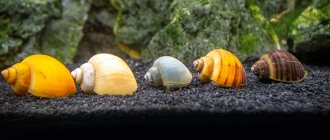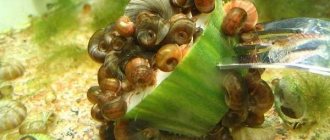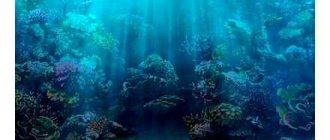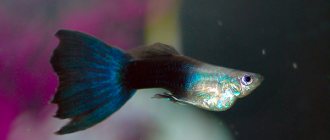Many novice aquarists do not know what to feed aquarium snails, especially since there are many types of snails. Some species of snails are carnivores, while others are vegetarians.
This article will answer the question of feeding snails and separately some species of the type: Ampularia, Coil, Helena, Theodoxus, Neretin, Mariza.
What to feed aquarium snails: Ampularia, Katushek, Helena, Theodoxusov, Neretin, Mariza
Aquarium snails or gastropods are irreplaceable orderlies who provide clean water and a favorable environment for the fish. These mollusks not only serve as indicators of cleanliness, but also decorate the aquarium. There are bright representatives that will decorate the water even without fish and other inhabitants.
The variety of species allows you to choose not only a beautiful individual, but also a useful one.
Helena feeding
Helena reaches 2 cm. It has transverse stripes of yellow-black color and is a predator. It happily eats smaller representatives: coils and melanias.
It feeds only on protein foods and does not eat plants in the aquarium. Ampularia can be dangerous for babies. Adults get along well together. If it lives in an aquarium with fish, it does not require special feeding.
Coil
The coil reaches 1.5 cm in diameter. Red or brown color. It feeds on the lower rotted leaves of aquatic plants. Often, reels are started to beauty the bottom or feed the larger representative of Helena. The colony reproduces quickly and can provide a complete diet for shellfish predators.
Ampularia
Ampularia is the largest representative of its species, reaching 5 cm. It has a bright yellow or brown color and long antennae. The snail is a vegetarian and prefers to eat plants and plaque on the walls.
Neretina
Neretina is the brightest representative of the species, reaching 2.5 cm in diameter. The color is varied: stripes and spots of different sizes. They come in black, brown, dark green with an olive tint. It gets along well with all fish, but can become prey for predatory representatives.
Neretina is active and is constantly searching for food. Does not require additional feeding if there is enough algae in the aquarium.
Cleans walls and fights plant overgrowth. It prefers rotting leaves, so it does an excellent job of cleaning.
Theodoxuses
Theodoxus are small, but very useful for maintaining an optimal habitat for fish. A sink with a variety of patterns: zigzag, stripes and specks of brown, black, white and olive. Under favorable conditions, they reach 2 cm in diameter.
By introducing shellfish into the aquarium, you don’t have to worry about the cleanliness of the walls and rotten plants.
Aquarium preparation
In order for river snails to live normally at home, they should create all the conditions for this.
The aquarium must be at least 30 cm wide; they can live alone or together with other inhabitants.
Clean water at room temperature is poured into the container, and any plants, including duckweed, are placed. The water temperature is not higher than +28, but not lower than +18. If there is a possibility that the water will cool below the established norm, then it is better to use a heater. The temperature regime must be observed, since at low temperatures mollusks can slow down their vital activity and hibernate.
Important! The lifespan of mollusks is 5 years, but if the water temperature is maintained from +19 to +25, this time can be increased.
Mollusks should select the necessary lighting and install filters to purify the water.
Food sources for aquarium snails
Aquarium gastropods are omnivores. Their diet consists of everything that settles on the bottom and walls of the aquarium. The exception is Helena, who is a carnivore and prefers protein foods.
Food sources for aquarium snails can be:
- food for aquarium snails. Consists of a dry balanced mixture of vegetables, fruits and herbs. It is sold in specialized stores. The amount required for a complete diet depends on the type of shellfish and their population. Manufacturers recommend using it as a top dressing;
- plaque in the aquarium. All representatives of the species crawl along the walls and clean off or partially eat plaque. Everything that is not eaten sinks to the bottom and there becomes a source of food for other individuals;
- aquarium plants. There are more than four hundred species, you can decorate an aquarium with any of them. Most species do not eat the algae themselves, but feed on dead leaves. If you control their population, then nothing threatens the plants. Shellfish control algae growth and make the bottom more tidy;
- live food Bloodworms, tubifex, daphnia, brine shrimp - this is a bloodworm. The predatory snail feeds on live food and, in addition to algae, can feed on live food: Helena, Tiara, Tilomelania;
- dead fish, fish eggs. Helena and similar representatives do not harm living fish, but happily eat dead fish and eggs;
- fish food When keeping shellfish together with fish, you don’t have to worry about feeding the little cleaner fish. The fish food settles on the bottom and becomes food for snails;
- vegetables and fruits. Carrots, cabbage, cucumbers, zucchini. Fruits include apple, pear and grapes. They are given in limited quantities, no more than 2 times a month;
- calcium for aquarium snails. Natural limestone, cuttlefish shell, mollusk and oyster shells will become an additional source of calcium. The shells are dipped into the aquarium whole or ground into powder and added to the water. This will become an additional source of calcium, which is necessary for normal life.
Prohibited Products
Some types of food for domestic snails are strictly not recommended. This may include:
- products containing bitter or pungent flavorings: onions, garlic, hot peppers;
- plant products with a high content of natural acids: sorrel, citruses, pineapples, cranberries;
- human food: sugar, salt, pasta, sweets;
- dairy products with a high fat content (cheese);
- fatty meat: pork, beef, lamb.
Attention! If you are not sure that a certain type of food is suitable for pet snails, you should not give it so as not to harm your pet’s health.
How to feed snails in an aquarium with and without fish
For living mollusks without proximity to other aquatic inhabitants, it is necessary to create their own diet. For predatory representatives, live food in the form of daphnia and bloodworms in the form of fine minced meat is required. Live food must be slightly ground with a knife, the food will sink to the bottom, after which it will be eaten.
If there are other types of snails in the container, such as coils, which become prey for the predator, then feeding the predator with live food is worth 1-2 times a week.
In cases of lack of food quality in aquarium plants, deposits on the walls, decorations and plants. Shellfish should be fed 1-2 times a day with spirulina, vegetables, fruits and herbs.
Fruits and vegetables need to be cut so that they can be easily removed from the aquarium. Fruits and vegetables can be given raw, but it is better to pour boiling water over them and leave for 5-10 minutes to kill unnecessary microbes.
For good health, all representatives need calcium, which may not be enough in the water. Buy mixtures with its contents in specialized stores, and your pets will feel great.
In an aquarium with fish, mollusks feel great without additional food, eating leftover food that is fed to the fish.
Interesting Facts
- Wild snails can serve as carriers (intermediate host) of the liver fluke (a dangerous parasite).
- They belong to the order of pulmonary mollusks and like to rise to the surface of the water.
- They densely inhabit Russian water bodies and are a common river snail.
- If the population of this species exceeds the normal limit, the pond snails are exterminated with lime. It can infect and kill a large number of livestock, being an intermediate host between animals and humans.
How often should you feed aquarium snails?
When keeping large predatory representatives, feeding should be daily at the rate of a pinch of protein food per adult. But you should carefully monitor the condition of the water. Cloudiness means that the shellfish are not eating the amount of food that is given out. Limit your diet and allow them to eat all leftovers and purify their water.
Small representatives should be pampered with additional feeding 3-4 times a month. The plants that grow at the bottom are enough for them.
In order to always have clean water and a good microclimate in the aquarium, you need to slightly underfeed the snails. And when living with other inhabitants, keep complementary feeding to a minimum.
Nuances of keeping bivalves
Freshwater bivalves can be viviparous (they immediately give birth to offspring consisting of copies of themselves reduced tens of times) or those that grow from larvae.
- Glochidia (parasitic larvae) adhere to other aquatic inhabitants and can grow on the body of a fish or aquatic turtle, for example.
- Veligers (larvae that feed on plankton) can attach to hard objects (snags, stones), and therefore do not cause much trouble, like glochidia. The latter seriously annoy the fish, which is why they often die.
It is also better to keep viviparous mollusks in shrimp tanks, although there is no accurate information about the interexistence of glochidia and crustaceans.
What and how to feed small snails
Under favorable conditions, snails reproduce, laying eggs once a month. If it is necessary to preserve the offspring, then it is better to remove all those who can eat the eggs. When babies are born, they are fully viable and need to be fed like adults. After two to three weeks, when they are stronger, you can put them into a common container.
With a separate aquarium for shellfish, nature will do everything itself. All that remains is to watch the birth of the offspring, and they will find food on their own and will eat what their parents eat.
These aquatic representatives are unpretentious and do not require special care. And they are very useful for their neighbors in the aquarium.
Where to get shellfish
River snails can be picked up on the banks of reservoirs. Among them, Prudoviki, Luzhanka and Pagoda are often found. You should choose healthy individuals, that is, those with no cracks or chips on the shells.
Such mollusks are omnivores and do not cause much trouble, but before placing them in a common aquarium, they must be quarantined. To do this, individuals sit in a separate container for several days. Special drops are added to the water for disinfection; you can purchase them at any pet store.
general description
The pond snail has a well-developed shell, twisted to the right. The front part of the body is visible from the shell. The head is wide, with a pronounced cervical interception. The surface of the body that comes into contact with water is completely covered with small cilia.
The pond snail has a well-developed shell, twisted to the right
Movement is carried out with a powerful flat leg. It's long enough. In times of danger, the leg closes the hole in the shell where the snail hides. The sole secretes mucus required for movement.
The pond snail is the most common type of aquarium snail.
Pond snails are classified as pulmonary snails. Therefore, they need air to live. Breathing is carried out through the lungs. To renew the air, the individual must rise to the surface of the water. During inhalation, you can hear squelching sounds, which are called the voice of pond snails.
Breeding
When introducing pond snails into your home aquarium, it is worth considering that they are hermaphrodites. Individuals have female and male organs. During mating, some mollusks play the role of the female, while others play the role of the males.
In the second half of spring or at the beginning of the first half of summer, pond snails lay eggs. Each clutch consists of approximately 120-150 eggs. Caviar can be seen at the bottom of the soil, on plant leaves, and on glass. After 3-3.5 years of light, small snails appear. The hatchlings have a transparent shell. Thanks to active nutrition, rapid growth is observed.
Attention! Sexual maturity occurs 1 year after birth.
Sex differences
If with fish everything is clear, how to distinguish them by gender, then with snails it is more difficult. Do not forget that pond snails are hermaphrodites.
In some sources you can find information that you can distinguish a male from a female by a number of characteristics:
- spiral shade;
- shell shape.
However, signs may change with age. The only way is to look at who is on top during mating. Often the male is on top.
Getting offspring
The pond snail does not need to create special conditions for reproduction. Individuals begin to lay eggs in the warm season. A heater can be installed for stimulation. The eggs are bound together by mucus. In appearance, the masonry resembles a small sausage with rounded edges. After 20 days, small snails begin to appear, which already have a full-fledged shell.
In the second half of spring, pond snails lay eggs
Reproduction occurs even if the individual has not reached the required age. Individuals can lay eggs when isolated from each other. They lay and fertilize eggs on their own. Without the participation of a second individual. Under unfavorable conditions, pond snails do not die. For example, if the pond is dry, the individual seals the hole in the shell with a special film. They can remain in this state for up to 30 days.
Enemies in the wild
Gastropods are among the most invisible organisms on earth. But despite this, the individual has enough enemies:
- sea gobies;
- sardine;
- sea stars;
- mackerel;
- whales;
- herring;
- hermit crabs.
For land snails, the following are dangerous:
- moles;
- blackbirds;
- wild boars;
- lizards;
- hedgehogs
Freshwater mollusks should be afraid of:
- trout;
- storks;
- frogs;
- herons.
Snails are slow and careful, which helps them protect themselves from enemies. They avoid highly lit areas and stay deep in the substrate.
Contact Hazard
Many experienced aquarists argue that it is best to keep pond snails in a separate aquarium. At the same time, preparing the necessary conditions for living. Since snails can destroy plants, they should be abandoned. The exception is hard-leaved varieties.
Many species of aquarium fish can eat shellfish. This may include:
- cockerels;
- macropods;
- cichlids
In addition, it is worth considering that pond snails are carriers of infectious diseases. Many diseases can be transmitted to other underwater species, destroying the entire fish population.











